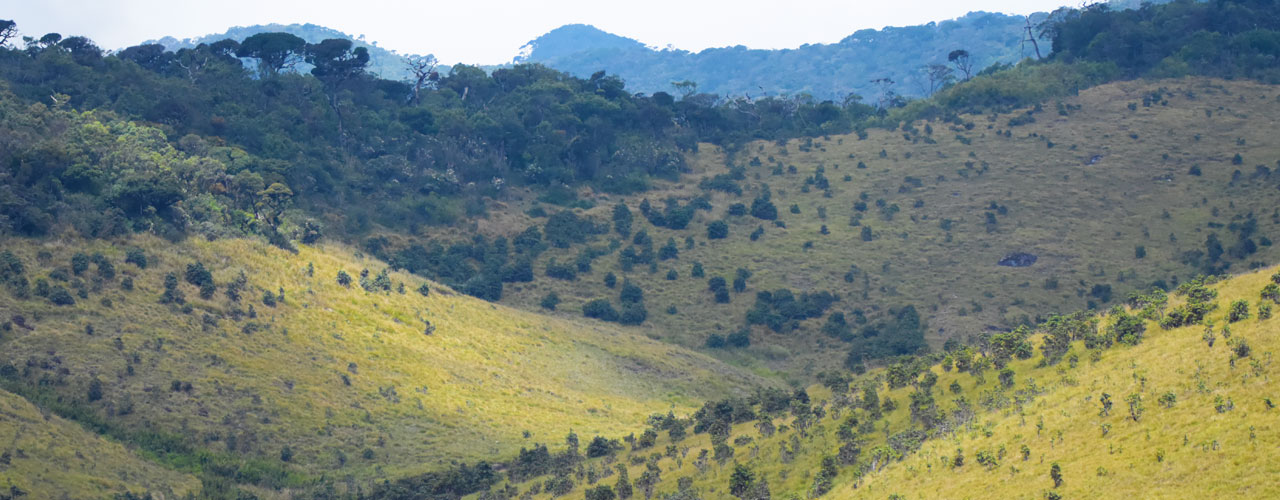Horton Plains
The famous Horton Plains is a nature reserve characterized by a beautiful landscape of rolling hills, forests, and grassland. The highest plateau in the island, spanning approximately 10,000 hectares, is home to 24 species of mammal - such as elk, deer, giant squirrel, wild boar, wild hare, porcupine, and leopard. The park also hosts unique vegetation and offers a perfect ground to observe many rare and endemic highland birds (87 species, 14 of which are endemic). An impressive physical feature in Horton Plains is the escarpment that falls 880 meters to the lowlands of the southern region of the island. Aptly known as the "World’s End", the precipice boasts a fabulous view of the tea estates below and all the way out to the distant southern coastline.
Horton Plains, or 'Mahaeliya' as it is traditionally named, is a popular weekend destination amongst locals. Therefore, we recommend to visit the park on a weekday when it is more peaceful.
Climate and Vegetation in Horton Plains National Park
The Horton Plains are located on Sri Lanka's highest plateau, between altitudes of 2,000 and 2, 300m. The landscape consists of undulating lands covered with tropical cloud of forests or verdant montane savannah grasslands, locally known as patannahs.
The best time to visit is early in the morning when the sky is the clearest and you can enjoy the best of the views. In the afternoons, clouds tend to descend and the area becomes submerged in mist. This is equally enthralling though and provides evidence for the evolution of this forest type. Allowing a half-day should give you plenty of time to enjoy it all at a leisurely pace.
History and Wildlife
Horton Plains were named after Sir Robert Wilmot Horton, a rather selfish and bloody-minded Brit who was singularly responsible for the slaying of all of the elephants in the area between 1831 to 1837. Although there is little hope of elephants ever returning, you may walk around admiring the many other interesting creatures around and about.
These highlands are home to one of Sri Lanka's least known mammals, the mouse-deer. For many years, it was believed that the mouse-deer found in Sri Lanka was the same species as in Southern India. In June 2005, Colin Groves a British taxonomist published a paper in a special supplement (No 12) of The Raffles Bulletin of Zoology whereby he distinguished three species of mouse-deer from Sri Lanka and India. The Indian mouse-deer (Moschiola indica) was split as a new species, and is considered now endemic to the Eastern Ghats of India. Also, the mouse-deer found in Sri Lanka was split into two new species: the white-spotted mouse-deer found (Moshiola meeminna) in the dry zone of Sri Lanka and the yellow-striped mouse-deer (Moschiola kathygre) found in the wet zone. Both species are endemic to Sri Lanka. Presently, this raised the number of endemic mammals found in Sri Lanka to eighteen species.
In his paper on mouse-deer from India and Sri Lanka, Colin Groves stated also that “a single skull from Sri Lanka's Hill Zone may prove to represent a fourth species”. The 'mountain mouse-deer' is evidently a very scarce animal. Most of the field staff in Horton Plains National Park had not seen one although they regularly encounter other nocturnal mammals including leopard.
In February 2008, a mountain mouse-deer was seen in quite exceptional circumstances by the wildlife populariser Gehan de Silva Wijerathne and Nadeera Weerasinghe, naturalist at St. Andrew's Hotel. With the permission from WLDC, it was temporally held captive for research and observation purposes and released back to the wild 2 days later.





















